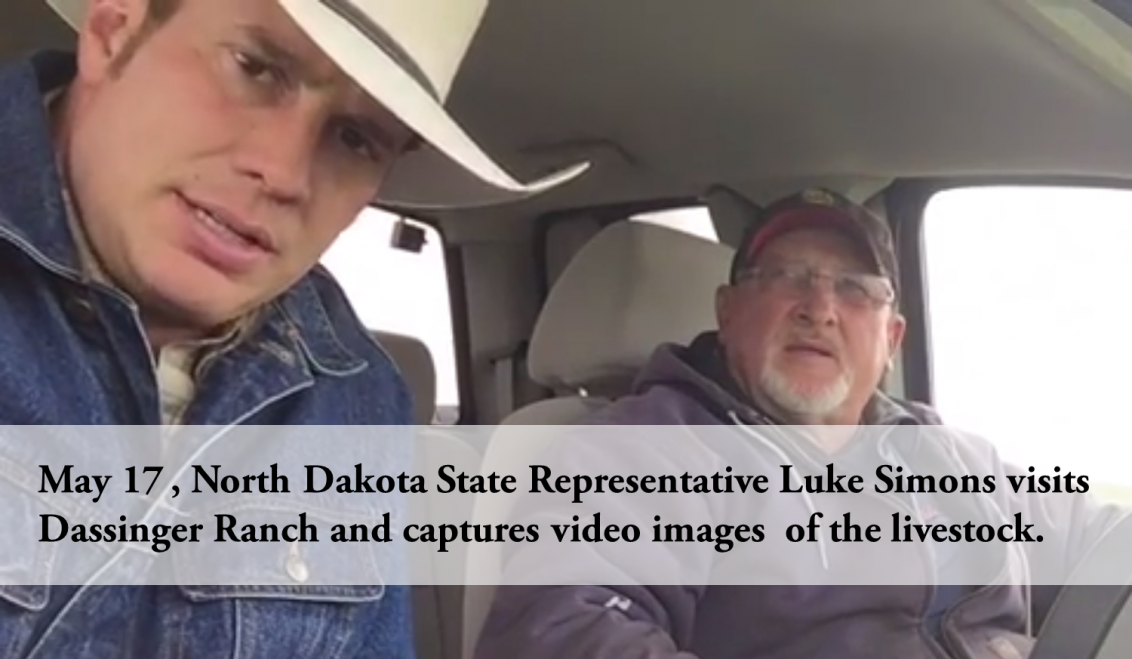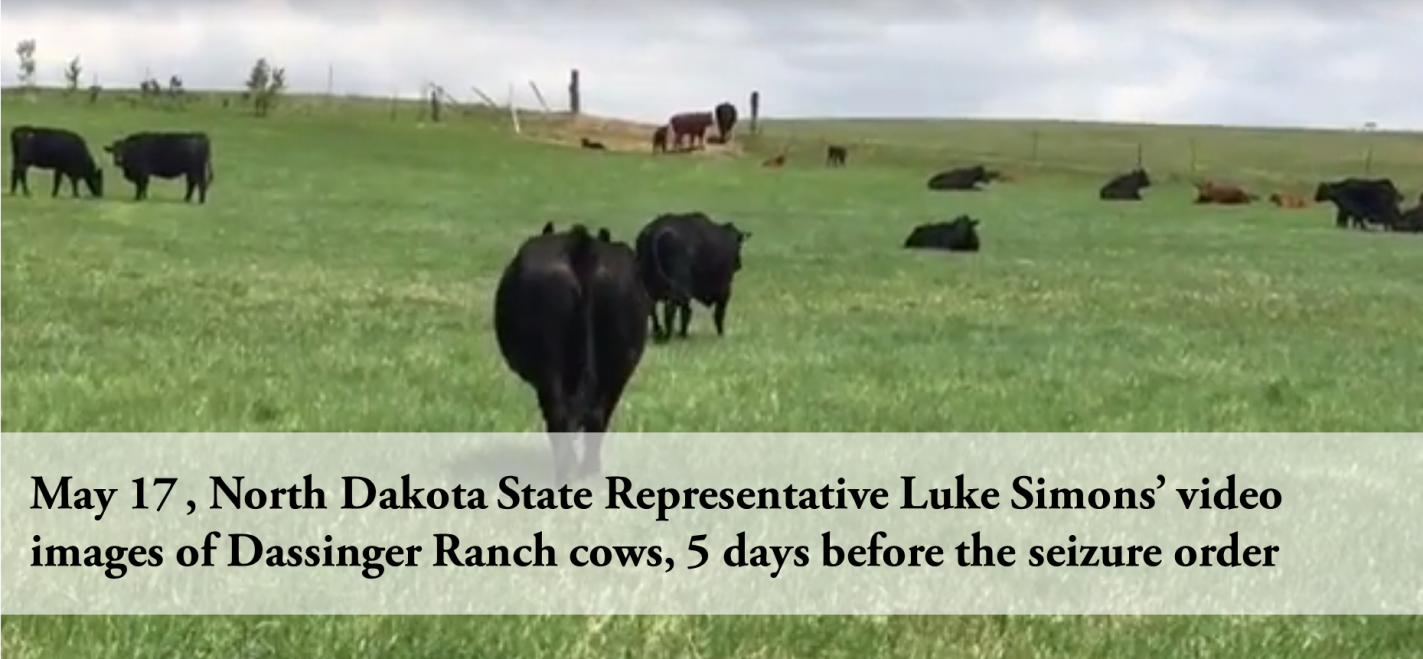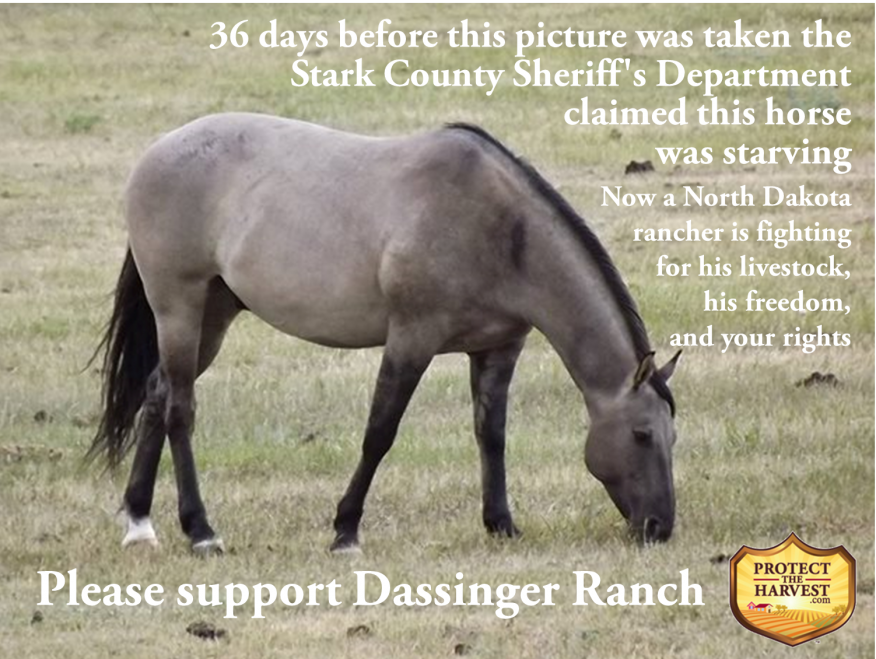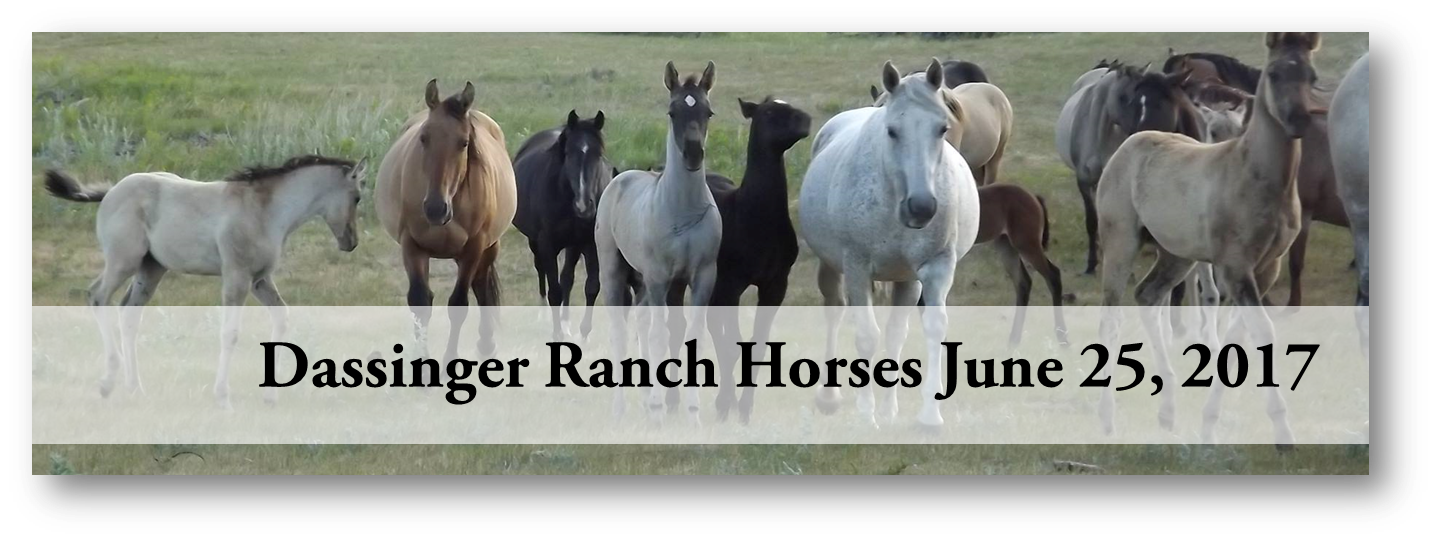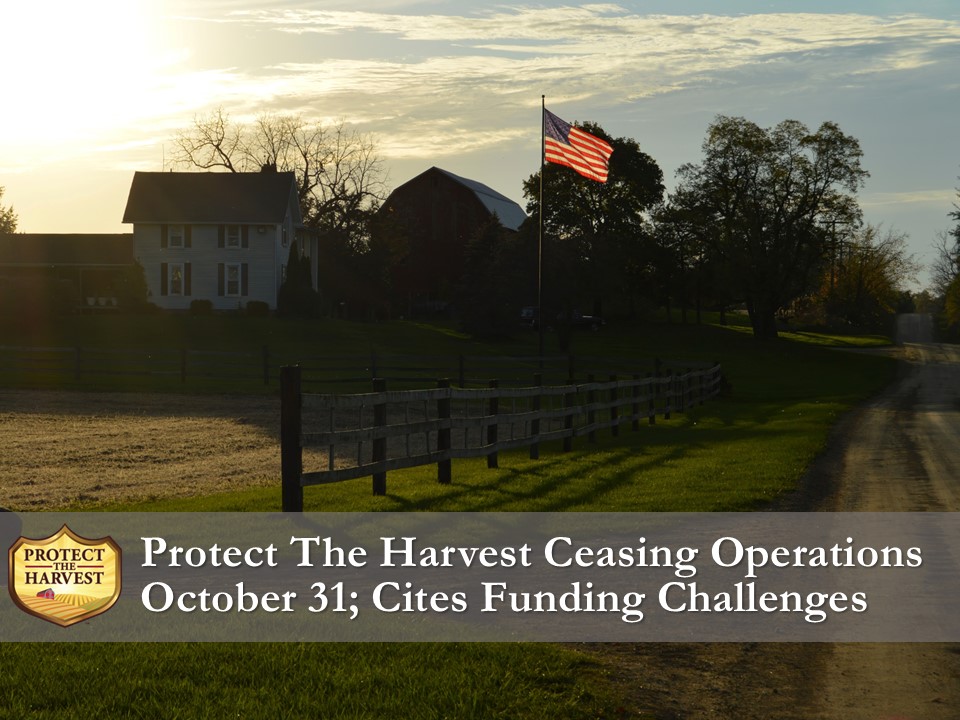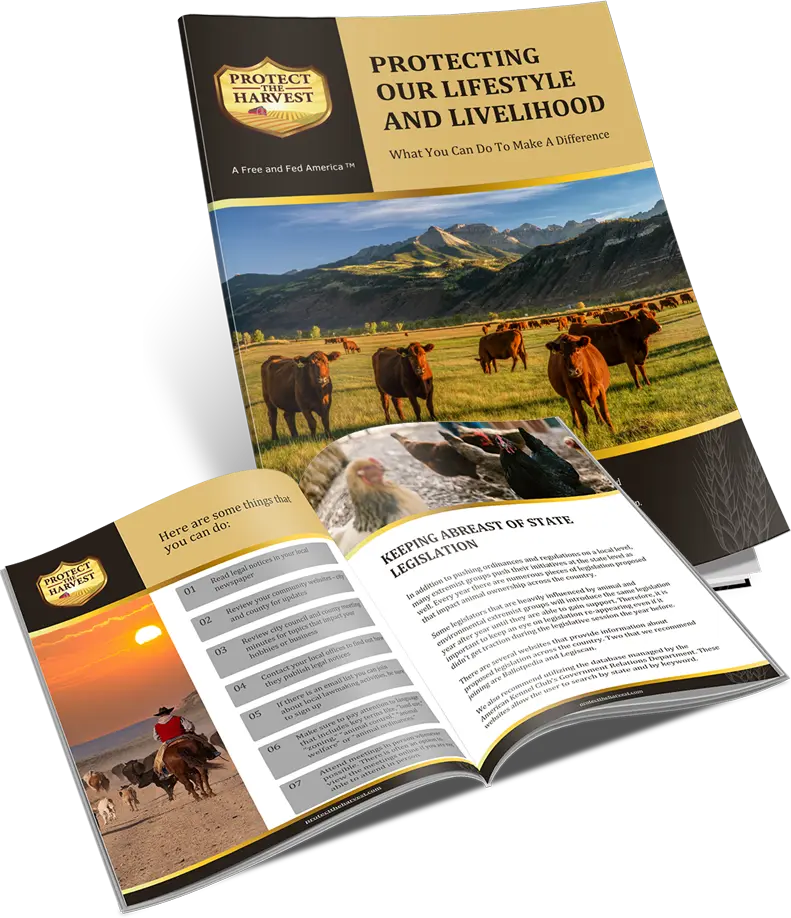North Dakota Rancher, Gary Dassinger is fighting for his livestock and your rights
Here we go again. Farmers, ranchers and pet owners need to pay attention to what has happened to North Dakota Rancher, Gary Dassinger. What’s happening to Gary looks just like a cookie-cutter template we have seen previously executed by the Humane Society of the United States. Just ask Dan Christensen, whose experience provided the framework for the story-line in our movie, The Dog Lover. This time the situation has far reaching implications and it has the North Dakota Farm Bureau and North Dakota State Representative, Luke Simons very concerned. Recent North Dakota legislation backed by the Humane Society of the United States (HSUS) and the Humane Society Legislative Fund (HSLF), a veterinarian with a twenty year old grudge and a judgement against her for defamation, an unscrupulous former employee and business partner, and inexperienced authorities who were trained in animal law enforcement by the HSUS, all combined to create the perfect storm designed to devastate Gary, his horse breeding program and his family members. He needs the support of the entire agricultural community. The results of Gary’s legal fight will have an impact on farmers and ranchers and animal owners in North Dakota and around the whole country. The story is long, and we hope you’ll stick with it to learn the truth of the matter.
Background on the law
In 2012, backed by the HSUS and their Humane Society Legislative Fund, Measure 5, North Dakota Prevention of Animal Cruelty Initiative was on the ballot and was defeated. However, similar legislation was then introduced to the North Dakota legislature despite major concerns voiced by the North Dakota Farm Bureau and other livestock and crop producers, like Gary and his daughter. The bill passed and became law in 2013. It is now listed as “Title 36, Livestock. Chapter 36-21.1. Humane Treatment of Animals.” It was designed with gray areas that put all animal owners at risk. There are a number of concerns in the language and we encourage reading through it. For the purpose of Mr. Dassinger’s case, we’d like to bring to your attention the following:
- 36-21.2-01. Neglect–Definition–Exemptions—Penalty 1. Any person that willfully engages in animal neglect is guilty of a class A misdemeanor.
- 36-21.2-02. Animal abuse–Definition–Exemptions—Penalty 1. Any person that willfully engages in animal abuse is guilty of a class A misdemeanor for a first or a second offense and a class C felony for a third or subsequent offense occurring within ten years.
- 36-21.2-03. Animal cruelty–Definition–Exemptions—Penalty 1. Any person that intentionally engages in animal cruelty is guilty of a class C felony.
- 36-21.2-10. Veterinarian If upon examining an animal a licensed veterinarian determines that there is reasonable cause to believe an animal has been neglected, abused, treated cruelly, or subjected to any act or omission in violation of this chapter, the veterinarian may retain custody of the animal and shall immediately notify law enforcement officials regarding the determination. Note: Shall means must. Therefore, by law the veterinarian must immediately notify law enforcement.
- 36-21.2-05. Seizure of animal–Court order 1. A law enforcement officer may petition the court for an order directing the seizure of any animal believed to have been neglected, abused, treated cruelly, or subjected to any act or omission in violation of this chapter. 2. The court may act without notice to the animal’s owner or to the person having custody or control of the animal and may rely solely on testimony or an affidavit in considering the petition. 3. In the order for seizure, the court may direct that a veterinarian humanely destroy an animal if the veterinarian, upon examining the animal, determines that the animal is experiencing excruciating pain or suffering and that the animal’s pain or suffering is not likely to be alleviated using reasonable medical interventions.
- 36-21.1-14 Assumption of custody – Immunity from liability. Any sheriff, police officer, licensed veterinarian, investigator, or person who has custody of an animal under this chapter and who is acting in an official or professional capacity and making a good-faith effort to comply with this chapter is immune from any civil or criminal liability for acts taken or omitted while attempting to comply with this chapter. Note: The term investigator is not defined, so that could mean anybody.
Dassinger Ranch
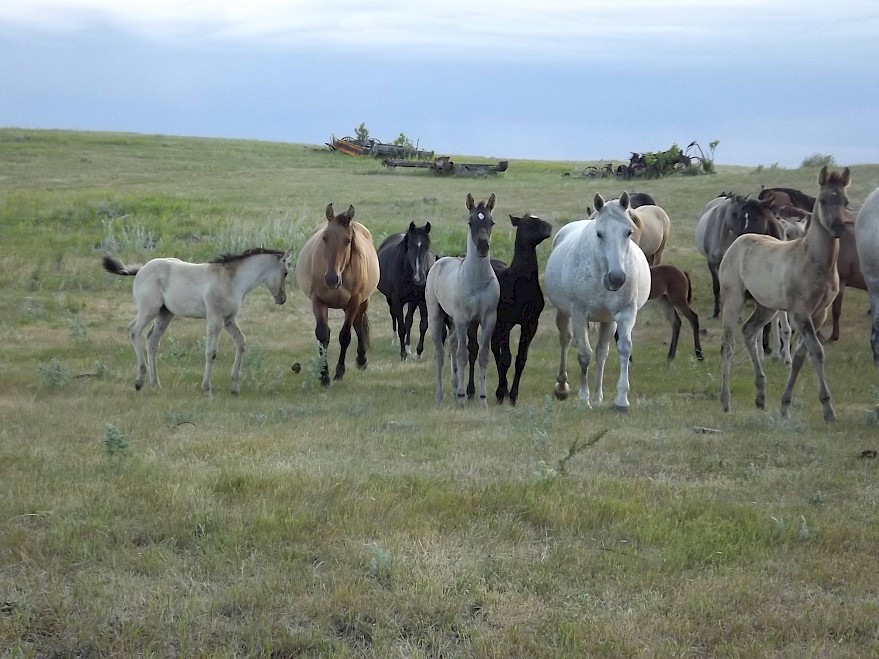
Gary Dassinger has a Masters in Social Work at the University of North Dakota and Bachelor of Science in Animal Science at North Dakota State University. As a Licensed Independent Clinical Social Worker, he owns a family counseling practice in Dickinson, North Dakota, near his ranch in Gladstone. When Gary is not at his practice, he is working over 1,000 acres on his family’s ranch, which has been in his family for three generations. He raises cattle and grows hay. Over the past 40 years Gary has been developing a line of sought-after ranch horses. He is proud of the registered horses he raises and his clients are horsemen and women from all over the country that are looking for solid-minded using horses with great color and conformation. Gary currently runs around 50 head of cattle and 80 head of horses. Gary took early social security and has not been able to sell as much of his livestock over the past 3 years. This is due to the restrictions on the income he can make. 2017 is the first year he would not be as restricted by his income from livestock. Gary was planning on selling his cattle in January of 2017. Gary and his daughter have been researching horse sale opportunities to have a partial dispersal in the fall.
The Set Up
In the last three years, Gary has developed some medical issues with his spine along with hip problems. In January of 2016, he had hip replacement surgery. Although he was feeling better, Gary soon realized that he was faced with more work than one man could handle. He began searching for reliable help on his ranch. After a few failed attempts, Gary decided he would sell off his cattle so he could focus primarily on the horses, since his previous attempts at finding help didn’t’ pan out. His next applicant, a man named John Connor, entered into the picture. John Conner claimed to be a twice divorced guy down on his luck that needed a break to get on his feet. He also presented himself as a master carpenter, horse trainer and equine massage therapist. On paper, he sounded like just what Gary needed to help him keep up with the care of his animals, train and prepare his young horses for sale, and help with much needed maintenance projects around the ranch. Plus, as someone who had also been divorced, and as a family counsellor, Gary was empathetic to John Connor’s story.
The Deal
Gary Dassinger first became acquainted with John Connor in the North Dakota Horse Connections Facebook group. John Connor visited the ranch at the end of October 2016, and helped fix fence with Gary as a working interview. He then watched over the ranch for several days during Thanksgiving. A deal was struck. In return for caring and feeding the horses, as well as horse training, John Connor was offered a place to live in Gary’s home and was to receive a share of the horse sales. Additionally, John Connor would be paid $12 an hour for carpentry work on Gary’s house, buildings and corrals. The construction work would provide John Connor with the opportunity to generate a regular cash income. In October, November and December, John Connor took a number of pictures of the livestock, proudly displaying their images on his personal Facebook page. He even used a picture of a group of Gary’s yearlings in a corral, eating feed as his cover image.
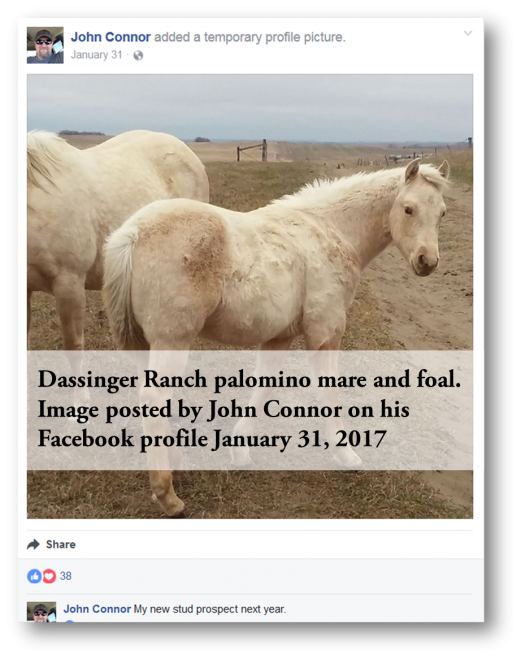
John Connor officially moved onto the Dassinger Ranch in December of 2016. He told Gary he needed to take some time off over the Holidays. Gary had been hopeful that John Connor would be working full time as soon as he took up residence at the ranch. However, he didn’t want to lose his new hired hand. Gary was worried about having to go it alone for another North Dakota winter. Although Gary had been planning on selling off his cattle, he asked John Connor if he would be interested in taking the cattle on share as a way to “sweeten the deal” so that John Connor would stay on. Gary already had hay on hand, and he would provide the feed, equipment and facilities. Gary reiterated that under this agreement, John Connor would need to take over full responsibility of the horses and cattle in January, 2017.
Both men wrote out an agreement:
- They agreed that Gary would not sell the cattle because John Connor was taking the cattle on share.
- John Connor would receive a portion of any horse sales he secured.
- He would earn $12 an hour for carpentry work.
- John Connor would take over full responsibility of the horses and cattle in January, 2017.
- Gary would help with the care of the stallions and geldings.
- Gary would provide feed for the animals until May, 2017.
In the middle of January, John Connor asked Gary for money. John Connor claimed he was behind on his child support. Gary also has children, and had to pay child support while they were growing up. Empathetic to John Connor’s situation, Gary advanced John Connor $300. In February, John Connor said his father was sick in South Dakota and he asked Gary for a loan of $600 so he could afford to go home to see him. Gary loaned him the money. When John Connor was in South Dakota, he contacted Gary and told him that that the current arrangement was not working for him. John Connor said he wanted a salary, rather than the $12 an hour. They agreed that John Connor would receive a salary of $1,000 per month, paid twice monthly in the amount of $500.00 in addition to the share agreement for the cattle and a percentage of the horse sales. Gary was nervous about his new help possibly walking off the job, so he wired John Connor $1,000 as an advance for February’s work. Gary Dassinger continued to work at his family practice but also helped with some of the responsibilities on the ranch. He filled in when John Connor needed to “take a day off every once in a while”. John Connor left the ranch at least once per month, often more.
The Stock
In December 2016, the colts were weaned and the thinner mares were separated from the rest of the herd to receive special care and feeding. Gary had purchased supplemental feed and had given instructions to John Connor to provide it to the horses that needed it. This included the other yearlings as well as an older dun mare that was pregnant. John Connor was instructed to feed oats to this older dun mare and a few other horses every day. One mare was not maintaining her condition during the winter. She was separated from the others in order to give her access to better feed. As John Connor was planning to market and sell the yearlings, Gary removed one of the best yearlings from the group. This was a black filly that Gary wanted to keep as a breeding stock replacement. This yearling was with a group of fillies and was only getting grass and hay but her body condition was maintained, and actually continued to improve with that feeding arrangement. Gary observed John Connor providing the supplemental feed to the horses and spoke with John Connor to confirm that he was following the feeding plan. John Connor assured him he was following instructions. By the end of February, Gary noticed the condition of some of the younger yearlings, who were August babies, starting to slip. Gary discussed his observations with John Connor. John Connor assured Gary he was following his instructions. As a part of the instructions, Gary told John Connor to make sure the yearlings were being fed individually. Gary wanted to make sure these younger horses were able to eat what they needed. On March 10, Gary’s veterinarian, Dr. Chance Noyce, visited the ranch to Coggins test colts. They were being prepared to be sold at the Hermanson Horse Sale, March 17 – 19. Gary also asked Dr. Noyce to check the horses that were thin as well as the older cows. The older cows were between twenty and twenty four years old, which is an advanced age for cattle. Gary noted that these cows had still raised good calves and as they were still producing, he did not have any sign that he needed to sell them yet. Dr. Noyce made some recommendations but did not find anything significant with the horses or the cows. Dr. Noyce observed that one of the cows had longer toes. Since this cow was pregnant, he recommended waiting until she calved to trim her hooves. He did not want to risk pre-term labor or the cow aborting the calf. Dr. Noyce also suggested that a red roan stallion may benefit from some dental work. Dr. Noyce recommended deworming a yearling that had started losing weight. On a follow up visit, Dr. Noyce reexamined this yearling since it was not improving. He recommended treating the yearling again with a different type of wormer to help ensure complete elimination of possible parasites. On March 20, the winter weather was fading so Gary instructed John Connor that, at minimum, he needed to start working with the yearlings. Gary noticed that John Connor only seemed be getting the livestock fed. Gary was unhappy about this because John Connor was not meeting the terms of the agreement regarding building repair and horse training as well as massaging a few of the older horses who John Connor said he could “get fixed up.” The yearlings still needed more handling as they had been briefly halter broken the previous fall. Gary also wanted them to receive individual grain rations, to ensure they were all getting adequate amounts. To address this, Gary instructed John Connor that he was to handle the yearlings one at a time and then feed them their blend of oats, 14% pellets, and molasses based feed before he turned them back out. In the middle of March, Gary moved the dun mare to a paddock closer to the house. He wanted her nearby when she foaled. He also wanted to ensure she was receiving the oats, 14% pellets and molasses based feed he had instructed John Connor to give her. This was the same blend that was given to the yearlings. Over the winter and spring, three of the older cows died. A younger cow got overbalanced and the timing of John Connor’s checking the livestock did not match up to when she needed help. By the time John Connor found her, it was already too late to help her get off her back and she died. A young mare was found dead by a water tank and appeared to have been electrocuted by a broken tank heater. The thin mare that was separated from the herd for extra feed was not responding and had to be put down. Gary had a rough spring in terms or livestock losses, but none of these animals starved to death. It is also important to note that numerous ranchers in the Midwest had also lost some livestock over the winter. It is a fact of ranching and farming that sometimes you lose livestock. Gary had heard about a farm program that reimbursed for lost cattle. Therefore, Gary instructed John Connor to remove the dead cattle to areas where live animals would not come into contact with them. However, they were not disposed of completely. Keep in mind; this is North Dakota in the winter time. The ground was frozen and covered in snow. So even if Gary could not take advantage of the cattle reimbursement program, at this time full disposal was very difficult. In order to maximize the amount of grass that could grow in his pastures, Gary moved his remaining hay. He wanted it closer to the stock that still required feeding. The hay was moved into the yard, near an area where there was some dead stock. However, the bales were far enough away so that Gary was not worried about any possible contamination to the hay. Gary was growing frustrated with John Connor. Over the past six years Gary had a 100% calf crop. Now that he had a hired hand, he was losing more stock. He lost two calves, and would later lose one more before he was done calving. Some of his cows had also died and Gary told his daughter that he was becoming increasingly concerned about John Connor and his care, or lack of care, of the animals. He told her he was starting to question John Connor’s experience managing cattle and his claims of being a horse trainer.
Horse Sales
During the next several weeks, some yearlings were being prepped for sale. In March, 4 horses were taken to the Hermanson sale in Mandan and were sold. These colts were in good sale condition. In fact, John Connor took a picture of these colts and used them as his cover photo on his personal Facebook page (see image above). At this sale, Louis, a horse trainer from California, bought some of Gary’s yearlings and wanted to buy more. Louis was very impressed with the quality of Gary’s stock. He mentioned to Gary that he did not own a lot of broodmares and they discussed plans for Louis to bring his stallions out to North Dakota. The goal was to produce even higher caliber foals and increase the market value of Gary’s stock. On April 15, Gary hauled 4 broodmares to western Montana to sell to a private buyer from Idaho. This sale was initiated by John Connor. When Gary arrived, the buyer initially wanted to pull out of the sale because John Connor had led her to believe the broodmares were very gentle and in show condition. These broodmares lived out on large pastures in North Dakota. When they were delivered they did not have slick coats and were not clipped. Fortunately, Gary was able to negotiate a lower price, and the sale still went through. The buyer talked with Gary about John Connor. She told him she was not impressed. She said she did not believe John Connor was trustworthy and expressed concerns about how John Connor was representing Gary and his livestock. She even recommended that Gary “get rid” of him. In addition to this, when Gary was on the road trip, John Connor told him that another calf had died. This brought his total loss to three calves in one calving season, which was very unusual for Gary.
John Connor Not Working As Agreed
In early April, Gary became even more frustrated that John Connor was not working as outlined in their agreement. By this time Gary had multiple conversations with John Connor about their agreement and the work that needed to be done. John Connor had only done minimal training with the horses. The young horses were not gentled or broke to lead as directed. He had not started to ride any of the older horses. Gary was not happy with how John Connor was handling his livestock either. John Connor’s method with the yearlings was to leave halters on them, and attach at least one, if not two lead ropes so he could catch them more easily. Some of the yearlings had received small injuries to their head. This method was not working. If anything, these yearlings seemed to be more fearful. John Connor had also not followed through on any maintenance and repair projects as agreed. After all the snow during the winter, there were more corrals and fencing that needed repairs in addition to other projects. Gary realized that John Connor would not “self-start” and his daughter recommended that he needed to provide more direct management. With a new approach, Gary was optimistic that if he kept better tabs on John Connor, he would start doing more around the ranch.
The Last Days
On April 17, John Connor texted Gary that he needed to “go home and do taxes.” John Connor indicated that he would be back on April 18, at 3:00 PM. This was a pattern with John Connor. On a regular basis something would come up and John Connor would have to leave the ranch. So, Gary was once again taking care of the livestock, waiting for John Connor to return. John Connor did not return on April 18. He returned on Wednesday, April 19. Gary put his foot down. John Connor was not following through with the promises he made in those previous conversations. Because of this, Gary told John Connor that he was terminating the monthly contract. John Connor would be paid only for work completed and at a specific amount per job. The next day, April 22, Gary was happy to find that John Connor started working on the fencing. It was the most work John Connor had done the entire five months. Gary believed that John Connor was finally on the right track. That afternoon Gary left to meet with clients. When he returned home John Connor was gone. Gary assumed John Connor was out at one of the local watering holes, which is something he regularly did. The following day, April 22, Gary noticed that one of John Connor’s horses was not in its pen. He then discovered that John Connor had cleared out and taken all his belongings. Upon that discovery, Gary realized that he would have to restock the feed for the animals. Gary noted that the older dun mare with a foal was out of water. He watered the mare quickly so she could drink something until he was able to refill her water tanks more completely. He headed out to take care of the rest of the livestock.
The Complaint – Made from Out of State
April 22, after Gary checked on the heifers that were left to calve, a Deputy Sheriff arrived at his ranch unannounced. The Deputy informed him that a complaint had been made. He said they were notified about dead animals on the property and that there were some that were thin. Later, through legal discovery, Gary and his attorney learned that the complaint was made by a person who had never even visited the ranch. Gary informed the Deputy that there were some dead animals and some thin animals on the property. He stated that his hired man (John Connor) had been responsible for taking care of the livestock. He then told the Deputy that John Connor had skipped out on him that day or the afternoon before. He also told the Deputy about the animals that had been receiving additional feed. He indicated that he would be caring for them himself and that things would be changing. The Deputy assured Gary that they just needed to check things out. The Deputy noted they were getting off a long winter and that this would probably be the end of the investigation. He left the ranch.
The First Seizure
On April 22, the same day it was discovered John Connor cleared out, Gary started moving animals around so he could restock all their feed. While Gary was out in one of the big pastures moving horses, a vehicle drove up the section line. It then drove into Gary’s pasture, approaching him. Inside the vehicle were Stark County Sheriff Oestreich and veterinarian, Dr. Kim Brummond. When Gary asked what they needed, Sheriff Oestreich said, “We have a problem.” Without letting Gary speak or asking him any questions, Dr. Brummond announced, “We are taking the mare and foal that are back at the house. There is no discussion. That’s what’s going to happen.” Gary asked, “Why?” and she replied, “So they don’t die.” Dr. Brummond was referring to the 21 year old dun mare and her foal. Gary was informed that the mare and foal were going to be moved to Dr. Brummond’s veterinary clinic. Gary said that he didn’t’ see any reason for them to be taken to a veterinary clinic. He also said he would prefer it be any other facility based on his previous interactions with Dr. Brummond. He asked if they could be taken to a stockyard or someone else’s property with a veterinarian checking in on them. The Sheriff informed Gary that it was out of his hands and up to Dr. Brummond. Not wanting, or able, to argue further, Gary then went back to the house with the Sheriff and Dr. Brummond. There he found a number of other vehicles and law enforcement officers walking around his property. This made him nervous. They did not have a search warrant, nor was Gary served with any documentation. Gary thought this whole thing was just a big misunderstanding. Once the Sheriff realized they would need a trailer to move the mare and foal into town, Gary was asked if he would transport them. Gary refused to do that. Instead, he acquiesced and offered to loan the Sheriff his horse trailer and hitch so they could haul the dun mare and her foal to Dr. Brummond’s veterinary clinic.
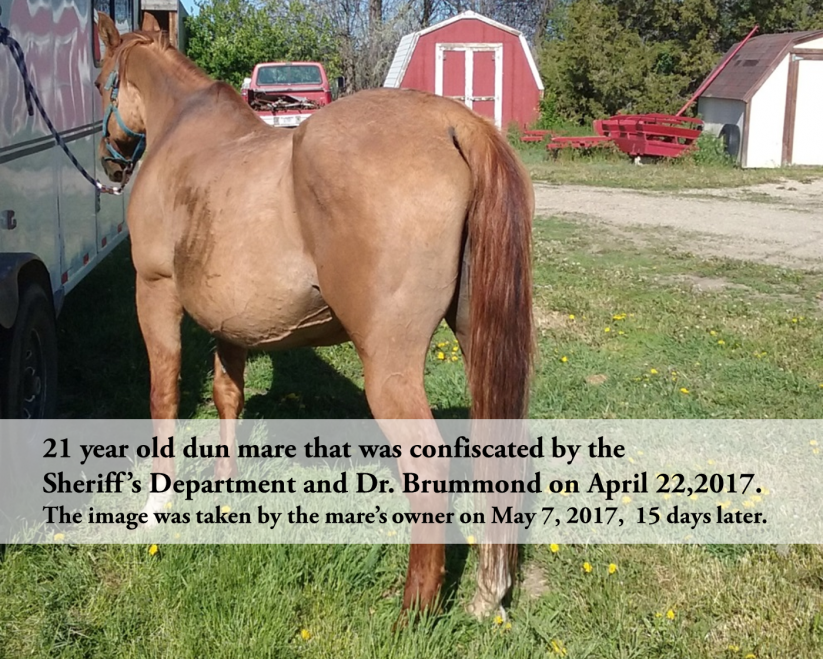
During this first encounter, Dr. Brummond had also asserted to the Stark County Sheriff’s Department that two horses needed to be euthanized due to lameness. She claimed one mare was unable to get up after lying down and was unable to walk without significant pain. This was something Gary had never observed. He stated to them that he did not believe that was the case. As their conditions were chronic, he knew there would be a day where it might be necessary. However, he believed they still had a good quality of life. They were not working and were living out on soft ground and pasture. Sheriff Oestreich told Gary he had to put the animals down and he had to do it that day. Gary was confused and distraught. He felt intimidated by the whole situation. Even though Gary did not think it was necessary, to prevent the situation from escalating, once again he acquiesced and put the two horses down. Gary now regrets that he didn’t get a second opinion. Later in the court hearing regarding the seizure, Dr. Brummond stated that she only did a full assessment on the dun mare and foal that were seized on April 22. Additionally, in one of the photos of Stark County’s own evidence, the mare Dr. Brummond claimed could not get up and walk, and that Gary was ordered to euthanize by Sheriff Oestreich due to Dr. Brummond’s assertion, can be seen walking comfortably of her own free will.
The Assessment
On April 25, Gary Dassinger received from his lawyer a written complaint completed by the State’s Attorney. The complaint demanded compliance with a list of conditions. It also stated that he had to work with a veterinarian to develop a health and nutrition plan and return it to the office by May 1. This complaint was based on Dr. Brummond’s opinion that multiple horses were a grade 1 out of 9. A separate report written by Sheriff Oestreich, stated that the animals needed to be removed immediately but where in such poor shape that transportation was not recommended. The Henneke horse body condition scoring system was developed by Henneke et al. (1983) at Texas A&M University. It is a universal numerical scale used to both assess horses’ bodyweight and evaluate the amount of fat on a horse’s body. The system is based on both visual appraisal and palpable fat cover of the six major points of the horse. It is a standardized system that can be used across all breeds without specialized equipment. A horse’s condition is assessed visually and by palpation. Henneke horse body condition scores range from 1 to 9 with one being poor and nine being extremely fat. In the Henneke scoring system the ideal range for most horses is from 4 to 6.
Compliance with Demands and Care of the Livestock
Gary Dassinger readily admits that some of his horses were not in ideal condition. Gary makes his living from his livestock and is proud of his breeding program. He had taken note that some of his animals appeared to be getting thinner. Considering how many animals he was managing, every livestock owner knows that there are sure to be a few animals in less than ideal condition. However, the condition of his animals was of major concern to him and he had been addressing this with John Connor. Gary contacted his veterinarian, Dr. Noyce, and asked him to come out to his ranch to inspect all of the livestock and develop a plan to comply with the list of demands. Wanting to ensure he was being thorough, Dr. Noyce developed his plan off of the written complaint. This is why so many of his “recommendations” match with the demands. He wanted to ensure all the aspects of the complaint were significantly addressed. The plan was completed on April 27. It was hand delivered by Gary to the Stark County State’s Attorney’s Office the next day, April 28, three days prior to the due date. At the time Gary submitted the document to the State’s Attorney’s office he asked to speak with the State’s Attorney concerning the plan of compliance. Gary was told the State’s Attorney was unable to speak to him so Gary requested that the State’s Attorney call him. Gary and Dr. Noyce followed through. On April 29, Dr. Noyce, his wife, and father-in-law came out to the ranch and took care of the yearlings. They noted that the yearlings did not seem to have been handled very much. On May 5, the cattle were dewormed and deloused. An investigator commented about moss in a stock tank. She claimed that because there was moss in the water, it would be “no good” for the horses. This assertion concerned Gary. Wanting to be proactive, he had the water in his stock tanks and wells tested. He did this despite the fact that water testing was not on the list of demands. Initially Gary thought this person was a veterinarian. It turns out she was the Stark County Assistant State’s Attorney. All those samples came back not only fit for animals to drink, but were fit for human consumption. Also on May 5, and then again on May 6, farriers arrived to trim hooves on the yearlings. Both farriers noted that they saw no problems with the condition of the horses. On May 7, Gary’s new ranch hand, JR, arrived to help care for the stock and comply with the list of Dr. Brummond’s demands. JR had previously volunteered at an animal facility that worked with starving horses. JR had heard from a friend in North Dakota that there was an opening on the Dassinger Ranch. JR called Gary. Over the phone Gary informed JR of the situation and of the urgency to find new help. JR had heard about Gary’s situation and wanted to go help save the animals. However, once JR started working with the stock it became clear to him that the charges against Gary were wrong. JR didn’t see anything that made him concerned about their condition. JR told Gary, “These horses have it made, with all the room they have to run and play, plenty of fresh grass to eat, and they are simply beautiful”. On May 12, except for the pregnant mares, JR and Gary dewormed the rest of the horses except for the pregnant mares. Treating the pregnant mares was not recommended at that time.
Repeated Unannounced Inspections
Dr. Brummond reported that Deputy Eldridge was on the property on “the day before April 22”, which would have been April 21. He reported the red dun mare and foal did not have water in their tub. However, in his statement to the Sheriff’s Department, John Connor said that he “fed and watered everything on Thursday” before he left. Gary and his family were not aware that Eldridge had been on the property that day. April 24, Major Kaylor showed up to see if the horses ordered to be euthanized were in fact put down. May 1, a Sheriff’s Deputy arrived at the Dassinger Ranch and said he wanted to know where the plan Gary had developed with his veterinarian was. Gary informed him it had been hand-delivered on the April 28 (which was three days prior to its due date). Several times during that conversation Gary asked if they were investigating John Connor since he had been the one caring for the animals. His questions went unanswered. On May 5, a Sheriff’s Deputy, and a State’s Assistant Attorney showed up to do an inspection. This was the day that the State’s Assistant Attorney made assertions about moss in the water tanks. There were other dates where Gary’s daughter and JR noticed Sheriff’s vehicles casing the ranch to inspect the animals. The frequent visits from the Sheriff’s department had an impact on his livestock and the horses were startled more easily than normal. Gary cannot substantiate if law enforcement did in fact enter his property unannounced many other times, but he suspects that they had.
The Secret Reassessment
On May 12, Dr. Brummond wrote a reassessment of the animals and submitted it to the court. Dr. Brummond had not returned to the ranch to examine the animals since the initial surprise visit on April 22, when the dun mare and foal were confiscated, nor was an official inspection completed by the Sheriff’s Department. Gary was not informed that a reassessment had even taken place on May 11. In fact, he had been informed that a reassessment would be taking place on May 12. In preparation for the reassessment, Gary had blocked his counselling schedule for the entire day of May 12, in order to be available. Interestingly, Dr. Brummond’s second assessment dated May 12, just 20 days later, reflected observations as far as condition scores similar to Dr. Woodruff’s assessment (see The Independent Veterinary Evaluation below).
The Independent Veterinary Evaluation
During this investigation, Gary and his daughter, a nurse who is serving in the military and stationed overseas, grew more concerned. They were worried about the behavior of the investigators. They were concerned that they were purposely being kept in the dark. Gary’s daughter recommended that he hire an outside veterinarian. She felt he needed an unbiased opinion from a veterinarian who didn’t know him, or his ranch. On May 17, Gary contacted, Dr. Carolyn Woodruff. He informed her about his current situation and asked if she would be willing to provide an honest opinion of the status of his animals, and his ranch. As a part of agreeing to make an assessment of the livestock at Dassinger’s Ranch, Dr. Woodruff informed him that she would make it a requirement to also prepare a report and send it to the State Veterinarian’s Office. Confident that she was not going to find any problems, Gary was relieved that she would be submitting the assessment. He was hoping her assessment would help clear up the situation. As a part of the conversation, Gary also asked Dr. Woodruff if she would be willing to examine a yearling palomino filly. The filly had the type of wounds an animal could get from running into and tangling in a wire fence. Dr. Woodruff said she would examine the filly. Dr. Woodruff conducted her inspection on May 18; 26 days after Dr. Brummond initially arrived at the Dassinger Ranch. She reviewed the list of demands and inspected the horses and cattle. She took 46 pictures as a part of her report. According to an interview with radio broadcaster Trent Loos of Loos tales, Dr. Woodruff explained that, “The lowest condition score present was 3”, and she reported that some of the animals were clear up in the 6 and 7 condition score area. She also commented about the fact that the animals had been assessed with a score of 1, just 26 days earlier. She said, “…I’ve been a veterinarian for 39 years and I’ve never seen a turn around like that…”
Loos Tales Interview with Dr. Woodruff:
Interest in Dassinger Ranch Horses
Gary sold a horse at the horse sale in Dickinson on May 13. After the sale, the trainer of that horse arrived at Gary’s ranch. He was interested in purchasing more. Gary also had two other interested buyers arrive at his ranch. Unsure of the requirements of the written complaint, specifically that he had been told he was under quarantine, but did not have any paperwork to prove it, Gary declined selling any further horses. Since this case has been in the news and videos of the horses have been viewed by the public, Gary has received numerous calls and inquiries about purchasing his horses. In fact, people that had volunteered to help remove the horses on May 25, later contacted Gary expressing their interest in breeding their mares to some of his stallions. Other individuals also indicated that they wanted to purchase some of his horses once the seizure order was removed.
Visit from North Dakota State Representative Luke Simons
Hearing about the case, Representative Luke Simons visited Dassinger Ranch on May 17. He interviewed Gary and took a tour, filming the livestock. Luke Simons then posted the video of the interview and the stock on social media to help make the public aware of the actions of the Sheriff’s Department. Luke Simon’s wife set up a GoFundMe account to help the Dassingers raise money for their legal expenses. Of note: Representative Simons was also a Stark County Volunteer Deputy. However, after the Sheriff’s Department learned of his support of Gary, Sheriff Oestreich called Simons and told him his services were no longer needed.

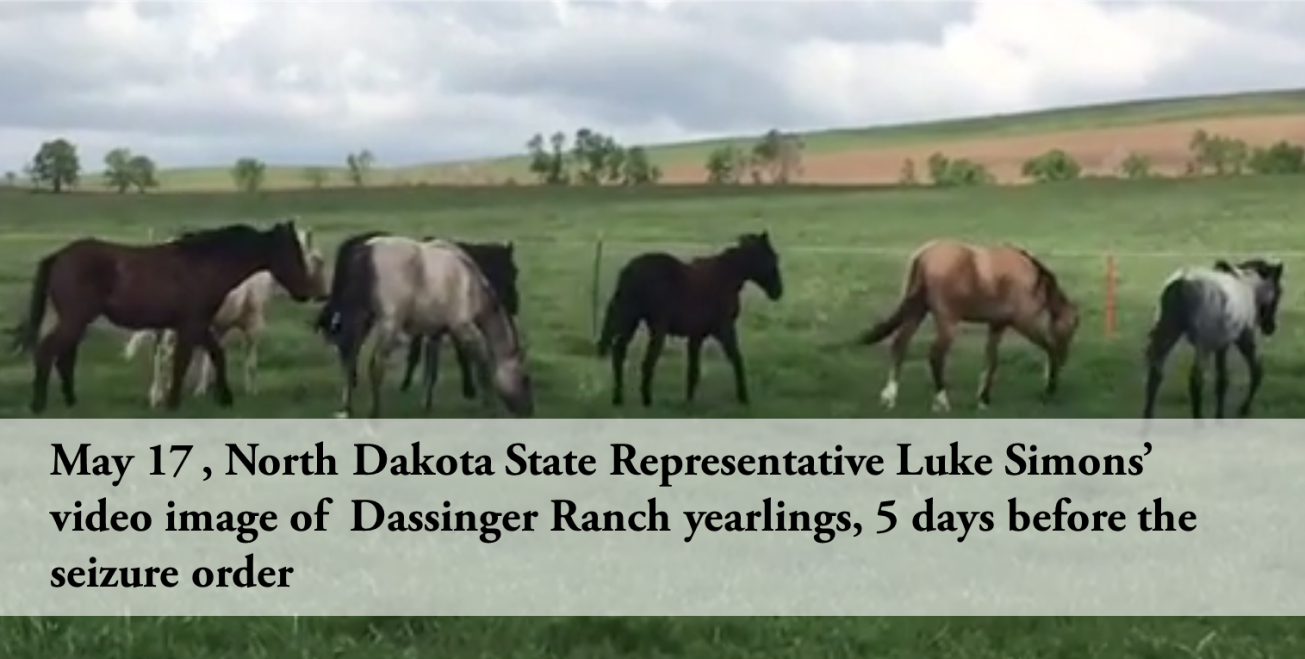
Boarding Horses and Ownership Claims
A horsewoman who has been buying horses from Gary for more than 10 years, bought 2, 2016 foals. These foals were born in August, and Gary told the new owner that she could leave the foals at Gary’s ranch until they were weaned. After the foals were weaned there were significant winter storms, and Gary recommended that she leave them at his ranch until the spring. After the events of April 22, Gary contacted the owner to inform her of what had happened. The owner wanted to pick up the foals/yearlings on April 29. However, Gary informed her that he was told that he was under “quarantine”. Wanting to be compliant, Gary told the owner that he felt he needed to confirm if he was under quarantine or not before she came to get the horses. When this owner heard about the seizure, and the pending removal, she contacted the Stark County Sheriff’s Department. Sheriff Oestreich told this owner that “all the horses belong to Triple H” and that she could not file a claim. The owner knew this to be incorrect and was able to get someone within the Sheriff’s Department to take down her information so she would have a record of her attempt to claim her livestock. Several of the mares on Dassinger Ranch were there to be bred to Gary’s stallions during their foal heat. There is a bill of sale for the mare and foal removed to Dr. Brummond’s veterinary clinic that support that that mare did not belong to Gary. When Gary learned that the horses were going to be seized, he contacted their owners. Those individuals were allowed to file ownership claims. Of note is the fact that many of the horses on the ranch were owned, or partially owned by his daughter. When she went to the State’s Attorney’s office and the Sheriffs Department to file ownership claims on her horses, she was denied.
The Planning Meetings
Even though Gary was served with a list of demands, plans were being made to seize the animals. These plans to seize and dispense of the livestock were being made despite the fact that none of the veterinarians involved recommended it; Dr. Brummond did not include a recommendation of seizure in either of her two written reports, Dr. Noyce saw no need for a seizure, and Dr. Woodruff stated that she would not have recommend seizing the animals. It was discovered that bills of sale were prepared to transfer ownership of the horses once they were seized. There were plans to remove the horses as early as May 11. There was a post on Dickinson Last Chance Companions Facebook page, that the Stockman’s Livestock Yard was contacted about selling Gary’s cattle. It was later learned that Larry Schnell of Stockman’s informed the Sheriff’s Department and the State’s Attorney that he refused to sell any of Gary’s cattle without his permission. The Stockman’s Livestock Yard has offered to testify to this fact. It was also discovered that during the planning process multiple people from different agencies informed the Sheriff’s Department and State’s Attorney that what they were planning wasn’t right. They were ignored and told to “stay in their lane”.
Continued Harassment and the No Trespassing Signs
Each day following the initial visit and serving of demands, the Stark County Sheriff’s Department had vehicles and officers casing the ranch. They drove onto the property, drove down the driveway, drove through hay fields and drove along fence lines. Along with the patrols, Deputies, an Assistant State’s Attorney, Dr. Brummond, and an Associate from Dr. Brummond’s clinic made numerous unannounced visits. They entered Dassinger Ranch property and questioned Gary, his hired hand, and his daughter who had arranged for leave from her duty in Japan about where the animals were on the property. As recently as May 2, the Sheriff’s Department and Dr. Brummond did not know where all of Gary’s cattle were and had to be directed to their pasture. On the advice of his attorney, Gary obtained additional “No Trespassing” signs and hung a chain over the end of his lane. On May 22, two vehicles from the Sheriff’s Department drove up to the property and parked at the end of the lane. Noticing that the two vehicles had been parked there quite some time, Gary and his daughter walked down the lane and approached them. One of the Sheriff’s Deputies, Major Kaylor, told them he was, “Just checking in”. He also said that he wasn’t going to be “…messing with a No Trespassing sign”. He ended the conversation by telling Gary and his daughter, “These horses are looking real good.” Gary’s daughter then returned to her work. However, the Sheriff’s vehicle remained at the end of the lane for 30 more minutes.
The Notification of “Seizure in Place” and Further Harassment
Major Kaylor left on May 22, and hours later, he returned with another deputy. Major Kaylor then informed Gary’s daughter they were looking for her dad. They were serving him with a “Seizure in Place Order”. The Deputy said, “We can come on the ranch whenever we want”. He told her he had the right to enter and he was going to see the animals. He then said, “I don’t know what your dad has told you, but it was a really bad situation when we first showed up”. The Deputy made comments about dead animals on the property. Gary’s daughter replied that if they had actually done an investigation and asked her dad what happened, he could have told them the circumstances. None of the animals starved to death, as Dr. Brummond implied. Gary’s daughter also told him about ranch life and the fact that it was winter when the animals died. In addition to the fact that hay production was very poor in the summer of 2016, the winter was long, and other ranchers had lost animals as well. The Sheriff’s department immediately increased their patrols of the ranch. From the time they spoke to Gary’s daughter, they drove by at least hourly for the next six hours. They drove up and down the lane and parked across the road. They even parked on a neighbor’s land across the road until he told them that they did not have his permission to park there. They drove onto the property and left gates open, or not properly closed. A gate opening directly onto the road in front of their property was left partially open. This would have allowed the horses direct access to the road. Gary, his daughter, and JR started following behind them because they were concerned about the safety of the livestock. In addition to the hourly patrols during the day time, the Sherriff’s Deputies would arrive at around 5 PM at their shift change and park at the end of the lane. They would stay there well into the night. Often there was more than one vehicle, and the officers would keep their vehicles running with the lights on, doors open and visit. They would occasionally shine a bright light up the driveway as late as 10:00 PM.
The Tip
On May 22, Gary was served with a Seizure in Place Order. The animals could not be removed from the Ranch. On Tuesday, May 23, Dr. Woodruff called Gary and his family because a reliable, concerned source informed her that there was a plan in place to actually remove the animals. The cattle were to be removed on Wednesday, May 24, and the horses on Thursday, May 25. Gary was informed that the horses were going to be hauled 500 miles away to a feedlot in Park River, North Dakota. This was devastating news for Gary as it would mean the end of his prized breeding program. Once others in the community found out the plan for Gary’s herd of horses, it started a barrage of phone calls to the State’s Attorney’s Office and Sheriff’s Department. The plan was changed for the horses. A bill of sale was issued to a horse welfare organization that had requested to step in and help. Since Gary and his family had learned that there were actually plans to remove the horses and cattle and to sell them, in preparation, they sorted them for loading. They separated the mares and foals and placed them in corrals. They were told one person might be taking all the geldings and stallions, so they sorted them out and put them all in one pasture. Their goal was to have everything in order to reduce stress on their animals should officials arrive to remove them. The cattle were not removed on Wednesday, May 24. In the afternoon, on the advice of his lawyer, Gary hired criminal defense attorney, Thomas Murtha. He stated that he would attempt to file an injunction with the court to issue a Temporary Restraining Order. The Temporary Restraining Order would stop the removal of the animals from Gary’s ranch. Murtha’s request pointed out that only the original April 22, assessment by Dr. Brummond was included with the request to remove and sell the animals. Missing were Dr. Brummond’s second assessment and the documents prepared by Dr. Woodruff.
The Second Seizure
On the morning of Thursday, May 25, JR went to check on a group of heifers who had yet to calve. He overheard one of the Sheriff’s Deputies talking to a friend on the phone, telling him, “There are a lot of really good horses here. You need to come early so you can pick out a good one or you’ll miss out.” Later on, the Sheriff and his Deputies arrived at the Dassinger Ranch. Trailers also started arriving at the ranch. They were lined up almost one half mile along the road in front of the property. The Sheriff’s Department set up a road block. Along with the Sheriff’s Department, there were volunteers from Triple H Miniature Horse Rescue. A group of staff members from Dr. Brummond’s clinic arrived with portable panels. One Sheriff’s Deputy apologized to Gary’s daughter. He said he had to follow orders but did not agree with what was going on. A volunteer quickly assessed the animals and said, “I did not volunteer to take healthy animals away from their owners.” This volunteer has offered to testify on Gary’s behalf. Before they even started loading animals the Sheriff’s Department was notified an injunction was pending. They only waited about a half hour before Sheriff Oestreich hollered out “We’re goin’ with it. Load ‘em up”. It was chaotic. It was clear that there were people involved who didn’t know what to do. There was a lot of yelling and running around.
Reporters and “The Press Area”
A number of reporters learned about the situation at Dassinger Ranch. When the first reporter arrived at the ranch he was denied entry by the Sheriff’s Department. He was told he was not allowed to enter a “crime scene”. Gary spoke with the reporter and arranged to pick him up at the road block. Once the reporter was in Gary’s vehicle the Sheriff’s Department could not stop him. Gary took the reporter in through a back gate and showed him the pasture and livestock. The reporter then asked Gary if he could finish the interview in his home. Once the Sheriff’s Department noticed the reporter heading towards Gary’s home, they made further objections. They told him he was not allowed to enter “…for his own safety”. After more confusion and fumbling around they eventually set up a “Press Area” where reporters could gather.
Judge Orders the Horses Returned
On the afternoon of Thursday, May 25, Southwest District Judge, The Honorable Rhonda Ehlis reviewed Murtha’s request and granted an injunction. She ordered all the animals to be returned. By this time, more than 10 horses had been loaded and were off the ranch. Some were on their way to West Dakota Vet Clinic for further assessment. Others were in route to Triple H Miniature Horse Rescue. Individuals from the Sheriff’s Department made the comment that it was all a big waste of time. They were going to be back to remove the animals again within 48 hours. It took some time to return all of the horses. One foal was difficult to load and eventually had to be sedated. One mare cut her pastern in the loading process. The day before, a foal was injured when it got spooked by one of the Sheriff Department vehicles. Gary called Dr. Noyce who came out to the ranch the evening of May 25, to provide treatment. Sheriff Oestreich came out on the property on May 26, with a bag of feed. He spoke with Gary’s daughter and said that the Sheriff’s Department realized that since they had seized the animals, they were responsible for their care. He asked where the mare and foal with the cut knee was so they could call a vet out. Gary’s daughter informed Sheriff Oestreich that they already had a veterinarian come out the night before because she had been told that the injury needed to be treated within 12 hours. Sheriff Oestreich also said he didn’t think any of the mares would give birth over the weekend. He said that since a lot of his “…guys don’t know horses…,” he didn’t see the benefit of them patrolling all weekend. However, the next day, a Sheriff’s Department vehicle was again patrolling the property.
The Hearing and the Witness List
A hearing was ordered for June 5, about the Seizure Order. John Connor, the man who was responsible for the care and feeding of the livestock was called to the stand as a witness against Gary Dassinger. In exchange for being a witness, John Connor has been granted immunity. John Connor claimed he was not paid and used his own money to buy supplemental feed for the animals. Gary has canceled payroll checks and feed invoices proving John Connor was lying on the stand. The veterinarian, Dr. Kim Brummond, who made the original assessment and report used against Gary Dassinger, was also called as a witness. It is interesting to note that prior to this case Dr. Brummond had a defamation judgement against herself in the amount of over $260,000. Dr. Brummond appealed and the North Dakota Supreme Court reviewed her case. In 2004, the Supreme Court confirmed the jury’s decision. During the hearing, Sheriff Oestreich claimed that the land the horses were on is over grazed. The State’s Attorney showed a photograph of a portion of the ranch that is rocky. Even during a rainy growing season, that area does not produce much grass. They did not show the photograph Gary provided of the pasture approximately 500 feet away from the rocky area that shows plentiful grass. They also did not show the images that have been captured by Representative Luke Simons. Those images show horses and cattle grazing on lush green grass in the pastures.
Interview with Dr. Woodruff
Radio commentator, Trent Loos interviewed Dr. Woodruff, and she talked about the seizure. Dr. Woodruff stated that it was hard for her to believe a law like this had been written and that animals can be seized and sold without notifying the owner. She stated, “All of us think that we are supposed to get due process. In this instance this man had not been charged with anything over this entire month. He had been given directions on what he should do to improve the situation and he had followed through on all of that.” She stated that the order was for every animal on the place except for his cats and dogs, to be immediately removed. It wasn’t just for the animals that had been assessed with a lower body score condition. Dr. Woodruff then commented about the lack of information provided to the court. She said that she provided Gary her written report within two days, on May 20. She also commented that she had made the State Veterinarian’s office aware of her assessment before the seizure was ordered, and the removal of animals from the property occurred. Dr. Woodruff said that the seizure order only referred to the first assessment made by veterinarian, Dr. Brummond, “Neither my report or the follow up report were presented to the court when the court ordered seizure was made.” She also commented that Dr. Brummond’s follow up assessment that occurred only 18 days after her first assessment was, “fairly similar to mine as far as condition scores.”
Update – Seizure Order Denied
Article in FreeRange Report.com – July 14, 2017 “Judge Rhonda Ehlis, of the Southwest District Court, ruled that there was not clear or “convincing evidence” that on May 18, 2017, the animals of Gary Dassinger met the definition of “neglect.” She further noted that, “Therefore, the Petition to Seize Neglected Animals and the Petition for Disposition of Seized Animals are DENIED. ” Link to article in FreeRangeReport.com: http://freerangereport.com/index.php/2017/07/14/correction-gary-dassinger-not-charged-with-animal-abuse-and-neglect/
Please note:
Even though Judge Rhona Ehlis ruled against the seizure order, Gary Dassinger is still facing a criminal trial. Gary has been charged with animal abuse and neglect based on Dr. Brummond’s April 22 assessment.
Please Help Support Gary Dassinger
Gary’s accuser lives out of state and has never even been to Dassinger Ranch. Gary’s legal fees relating to the seizure order and hearing have been very costly. He has had to borrow money from his daughter. There are more significant legal expenses on the horizon.
Link to GoFundMe for Dassinger Ranch HERE
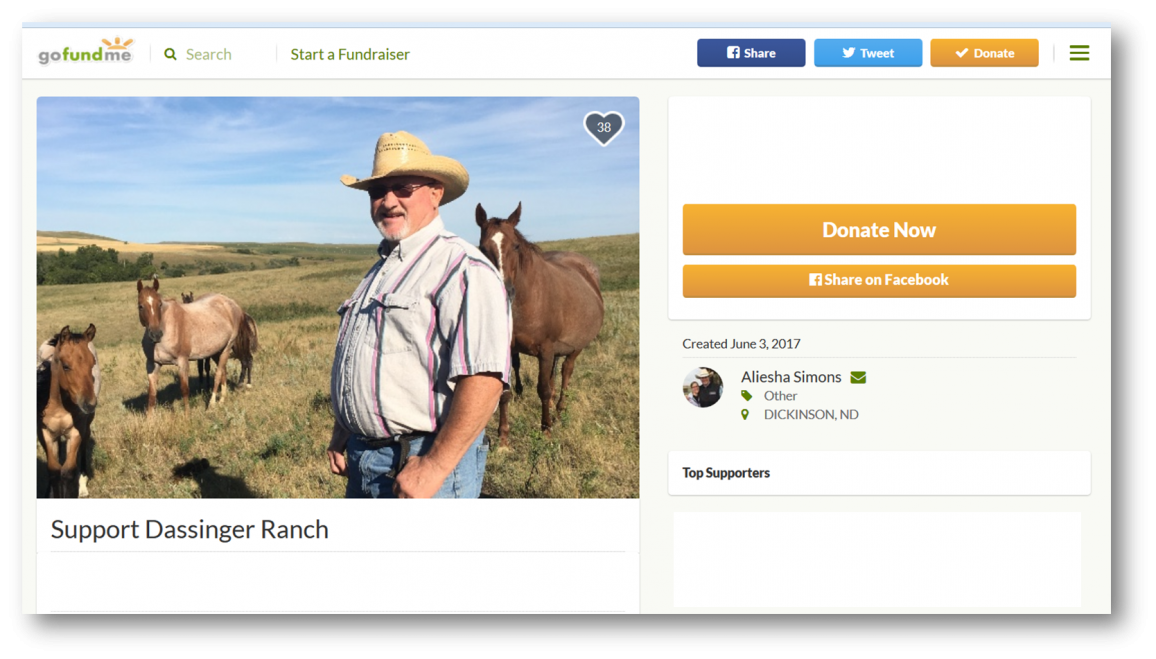
New North Dakota Law
This is a relatively new North Dakota law. It was introduced by the Humane Society of the United States and pushed by their Humane Legislative Fund. Since it became law, it has never been tried. That is because historically, the numbers of animal abuse and neglect cases in North Dakota have been few and far between. The HSUS has also come into North Dakota and trained law enforcement agencies on their interpretation of animal law and how law enforcement should handle animal welfare complaints. On his radio show Trent Loos commented about the new law and the fact that he had testified against it when it was only a bill, “…I know that this law existed for a terrible reason. Four years ago I and a group of people like minded were at the Capital testifying against this very bill.” He said, “I told them and there were many people from North Dakota that said this was going to happen, and so I don’t want to be the one saying, “I told you so”, but there’s a large group of people that said, “You can’t let this happen”. You can’t have somebody’s property removed from them before they’re found guilty.” Trent went on to explain that under this law any “observer” can report an animal owner to the authorities. He said, “Anybody could live through the same experience, if you have a neighbor, a veterinarian or anyone in the county that’s upset with you. That’s what’s troubling more than anything.”
Landmark Case
This is a landmark case against Gary Dassinger and the outcome will have a significant impact on farmers, ranchers and animal owners everywhere. According to the new law, even if Gary’s innocence is proven, there is no liability for the accuser. That means a person can falsely accuse someone of animal abuse or neglect, causing them undue harm and financial hardships in order to prove their innocence. The person who makes the false accusation gets away with it. They don’t get punished for making false accusations or have to pay any fines or legal fees. Gary will have to pay his attorney and the court costs regardless of the outcome. Please consider donating to help Gary with his legal fees. He is not only fighting this fight to save his ranch and his breeding program, but he is fighting for us all.
Additional Links:
Link to Support Dassinger Ranch GoFundMe HERE.
Link to Supreme Court Decision – Dr. Brummond Defamation Case HERE.
Link to Support Dassinger Ranch Facebook Group HERE.
Link to Representative Luke Simon’s Video HERE.
Link to article about HSUS training North Dakota law enforcement HERE.
Interview with ND Farm Bureau President HERE.

